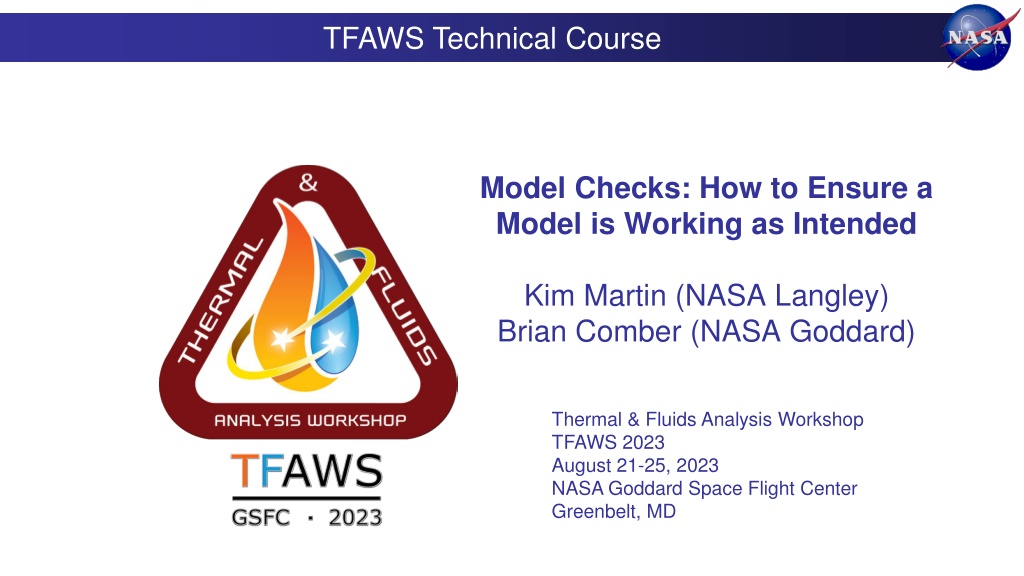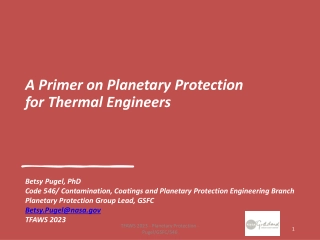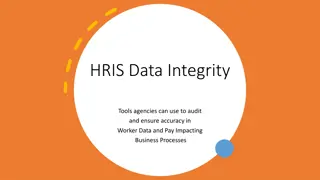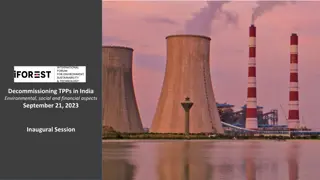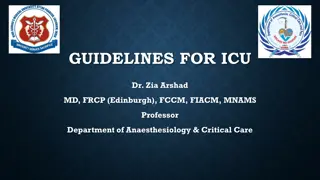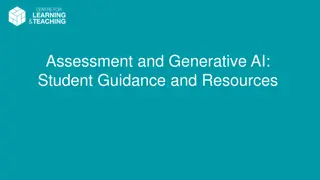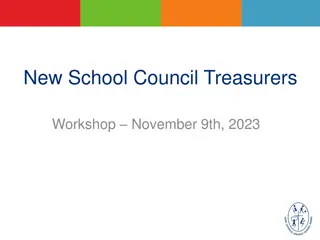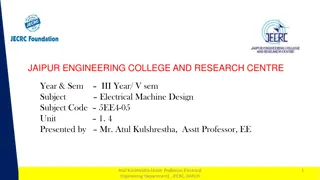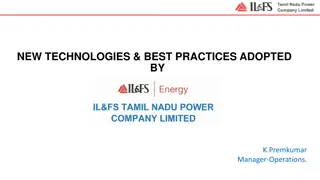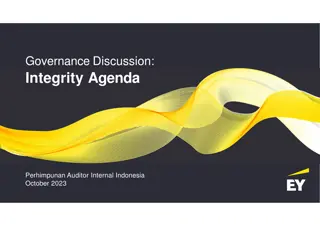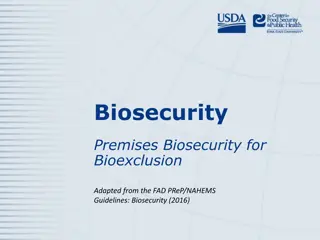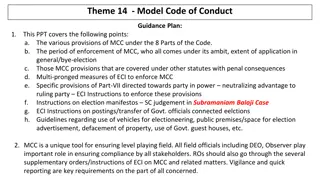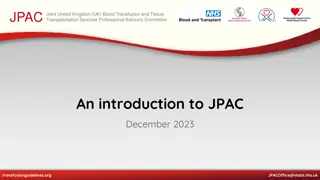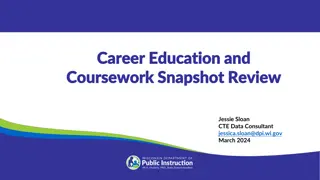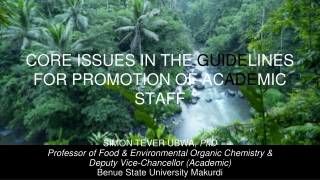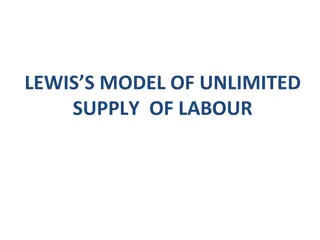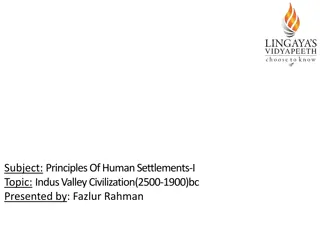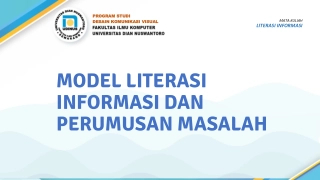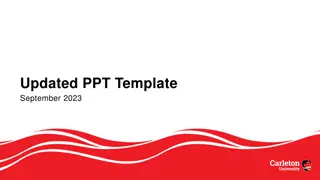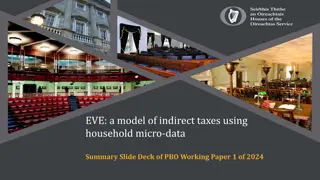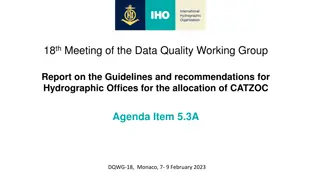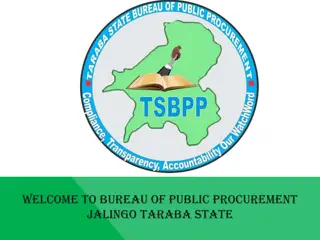Ensuring Thermal Model Integrity: Best Practices and Guidelines
Learn how to conduct effective model reviews to validate thermal models, identify errors, and enhance overall reliability. Discover the importance of independent assessments, ideal timing for reviews, key aspects to encompass, suitable reviewers, and timeframes for different model complexities.
Download Presentation
Please find below an Image/Link to download the presentation.
The content on the website is provided AS IS for your information and personal use only. It may not be sold, licensed, or shared on other websites without obtaining consent from the author. Download presentation by click this link. If you encounter any issues during the download, it is possible that the publisher has removed the file from their server.
Presentation Transcript
TFAWS Technical Course Model Checks: How to Ensure a Model is Working as Intended Kim Martin (NASA Langley) Brian Comber (NASA Goddard) Thermal & Fluids Analysis Workshop TFAWS 2023 August 21-25, 2023 NASA Goddard Space Flight Center Greenbelt, MD
Course Outline Basics of Thermal Desktop Model Reviews Thermal Desktop Model Checklist Goddard and Langley Model Audit Outputs Additional Tools Demos TFAWS 2023 August 21-25, 2023 2
Basics Why should you do a model review? Independent assessment builds confidence in the model both for the analyst and project Another perspective can show longstanding model mistakes and incorrect simplifications Even experienced analysts can use a second opinion and outside checks Builds model knowledge and capability in early career analysts When should a model review be done? Commonly at Langley, before milestone project reviews like Preliminary Design Review (PDR) and Critical Design Review (CDR) Additional reviews could be done as needed (e.g. prior to system-level testing, model delivery, or integration into a higher-level model) What does a model review encompass? All aspects of the model, including base geometry, thermal desktop elements like connectivity/heat sources/model logic, thermal radiation, and results Could be done in conjunction with document review (e.g. model reports, project milestone slides) TFAWS 2023 August 21-25, 2023 3
Basics Who should perform a model review? For simple models with common features, any engineer with exposure to thermal modeling practices It can be valuable even for early-career engineers to do model reviews, to gain exposure to model techniques For specialized models with unusual features or analysis techniques, it is valuable to select a reviewer familiar with the subject matter Best practice is that the reviewer is not an engineer associated with the project How long should a model review take? For many Langley thermal models (electronics boxes, small satellites), two weeks is a standard window to give the reviewer For more complicated models, a monthlong window might be more realistic Actual labor time is typically day to 2 days Larger models, such as full spacecraft, might take months and multiple analysts Request a model review as soon as reasonably possible, to ensure time to assign reviewer and complete the review TFAWS 2023 August 21-25, 2023 4
Basics What should be delivered for a model review? The model, with all relevant files Thermophysical and optical property files External model logic files Any xref files Supporting documentation or files (e.g., CAD, review slides) Model log or documentation, if used Model output template, if used TFAWS 2023 August 21-25, 2023 5
Basics Self reviews vs. peer reviews The checks in this document can be used by the original analyst as well It is a good practice to self-review a model using some or all of these checks prior to requesting an independent review Reference documents when doing a review NASA Passive Thermal Control Engineering Guidebook Cross-center thermal best practices document Cross-Program Design Specification for Natural Environments (DSNE) General reference document for common space and planetary thermal environments Lunar Thermal Analysis Guidebook (LTAG) Moon-specific environmental document, with Thermal Desktop modeling guidelines This Slide Package Most common issues found during model reviews Units Property assignments Incorrect logic Radiation surface assignment Contactor errors TFAWS 2023 August 21-25, 2023 6
Demo Model We generated this future NASA concept as a way to show some of these checks in real-time today We will switch back and forth between a detailed checklist and this model as the course progresses Model demos denoted by TFAWS 2023 August 21-25, 2023 7
Model Units Check unit preferences in Thermal Desktop General standard for NASA is all SI units, but some projects may choose to make exceptions, particularly for lengths Caution: check user logic for problems that could arise from changing units Make note of model units for reviewing: Model objects that use symbols xrefs Command: Rcpreferences TFAWS 2023 August 21-25, 2023 8
Sanity Check Against CAD Ideally, Computer Aided Design (CAD) and Thermal Desktop geometry should have the same coordinate system for ease of import Checker should import CAD and ensure that the thermal geometry reasonably matches. Check critical dimensions like thicknesses, if necessary Determine if the model is using surfaces vs. solids properly If post-processing data mappers are present in the model, ensure that they align with thermal model TFAWS 2023 August 21-25, 2023 9
Radiation Analysis Groups View model by each analysis group (via Model Browser) Check for missing or extraneous surfaces Zoom Extents is useful to make sure all surfaces are visible on screen May not work correctly if xrefs are used If symbol-driven assemblies or trackers are used, try changing the symbols to make sure the whole radiation group moves together Ensure that there is only one external radiation analysis group and internally- facing surfaces do not use that group Command: Rcmodelbrowser TFAWS 2023 August 21-25, 2023 10
Radiation Analysis Groups Display active sides for each analysis group Look for inverted or double-sided surfaces that don t make physical sense Command: editActivePrefs TFAWS 2023 August 21-25, 2023 11
Optical Properties View model by optical properties Property name, absorptivity, emissivity Look for unexpected changes in properties on single bodies, or unreasonable values Look for surfaces assigned DEFAULT optical properties in the model browser Command: editPropData TFAWS 2023 August 21-25, 2023 12
Thermophysical Properties View model by material properties Property name, conductivity, specific heat, density, thickness Look for unexpected changes in properties on single bodies, or unreasonable values Look for properties assigned DEFAULT material in the model browser Be sure to assign unique colors to property names when viewing by name TFAWS 2023 August 21-25, 2023 13 Command: editThermoPropData
Insulated and Multilayer Insulation (MLI)-Covered Surfaces View surfaces that have insulation via Model Checks Display Active Sides Insulation) Ensure insulated surfaces are using insulation-related optical properties Command: editActivePrefs TFAWS 2023 August 21-25, 2023 14
Insulated and MLI-Covered Surfaces Plot surfaces by e* value Plot surfaces by k* if applicable Command: RcPlotEStar RcPlotKStar TFAWS 2023 August 21-25, 2023 15
Optical Property Database Verify that all optical properties have properly assigned values No placeholder values All properties have reliable sources listed, such as published papers or vendor datasheets Check for duplicate properties with similar names Check that aliases are set appropriately Command: editPropData TFAWS 2023 August 21-25, 2023 16
Thermophysical Property Database Verify that all material properties have properly assigned values No placeholder values All properties have reliable sources listed, such as published papers or vendor datasheets Check for duplicate properties with similar names Check that temperature-dependent properties have properties over all temperatures predicted for the material Check that aliases are set appropriately Command: editThermoPropData TFAWS 2023 August 21-25, 2023 17
Mesh Density Turn on surface visibility Visually check for reasonable mesh density Are there sufficient nodes to capture heat paths? Are there nodes located where contactors are connecting? Are there places where it would be better to merge nodes instead of using high-value conductors? Plot by skew Thermal Desktop will abort the run (if checked in User Preferences: Calculations) if skew is above 0.999 Address areas of unacceptably high skew by re-meshing if possible Command: Rcpreferences Command: _RcPlotSkew TFAWS 2023 August 21-25, 2023 18
Geometry Checks Overlapping Surfaces Writes a log file (CheckOverlappingSurfaces.log) to model directory listing any surfaces overlapping above user-input threshold value Tool described later in presentation can help parse the output Show Free Edges Highlights discontinuities in finite elements with a red line Shows the outline of a finite element mesh as well, which is normal Show material orienters for anisotropic solids and surfaces and verify proper assignment and alignment Command: RcCheckOverlappingSurfaces RcFreeEdges TFAWS 2023 August 21-25, 2023 19
Conductors/Contactors Show all contact/contactor markers Verify that the contactor faces are set up in a physically meaningful way For a large model, it may be better to do this in batches Open each contactor via the model browser Check contactor values Check warning messages Via show calcs in each contactor and checking the command window output, or run a case and check the ContactorData folder Use Display Only for the from and to surfaces separately Best practice is that the from surface has larger area than the to surface. If this is the case, the contactor will show up as green in the Model Browser. Red contactor indicates the from surface is larger than the to surface Contactor Markers Command: RcShowContactorMarkers RcShowContactMarkers TFAWS 2023 August 21-25, 2023 20
Mass Do model mass check Select the whole model, or portions, and use the Calculate Mass feature Is the model close to total mass Current Best Estimate (CBE)? Are submodel masses close to submodel mass CBE? Command: RcCalcMass TFAWS 2023 August 21-25, 2023 21
Nodes Check nodes by shape of node Sphere: Diffusion or generated by surface Cube: Overridden to arithmetic Pyramid: Overridden to boundary Check for arithmetic nodes overridden by surface, use "Generate Nodes Option" by sequence shown in screenshot 0=material property, 1=arithmetic Ensure arithmetic nodes or diffusion nodes not associated with surfaces are properly applied Command: RcPlotGenNodes TFAWS 2023 August 21-25, 2023 22
Nodes Disposition any duplicate nodes In the case set manager, ensure that "prompt if duplicate nodes found" is checked Duplicate nodes may be acceptable for merged interfaces, but generally not desirable (merge nodes instead) Use "Duplicate Node Exceptions" in case set manager and maintain the warning for the future Command: RcCaseSet TFAWS 2023 August 21-25, 2023 23
Conductance/Capacitance Check multipliers on density and conductivity on surfaces and solids A large override may indicate a nonphysical representation If using a density override, use conductivity override values to match Check nodes over-ridden for thermal mass Create cc file and check for errors Command: RcPlotDensityMult RcPlotKuMult RcPlotKvMult RcPlotKwMult TFAWS 2023 August 21-25, 2023 24
Model Connectivity Test Save as a new model and check internal connectivity Connect each internally-continuous body to a boundary node, turn off radiation and convection, and run steady state to ensure that all surfaces are connected as intended Turning off all heat loads except for one or adding a very high-value heat load can help visualize the heat flow TFAWS 2023 August 21-25, 2023 25
Heaters and Heat Loads In the model browser, check each heater and heat load and Thermo- Electric Cooler (TEC) Plot surfaces and markers for each heatload, to understand where they are applied Verify consistent units (absolute? Per area?) Verify enable/disable flags Verify thermal heat dissipation is electronics waste heat and not necessarily electronics power Check heater performance in .sav or .out to ensure they are working as expected. Print out duty cycles in .us* file. TFAWS 2023 August 21-25, 2023 26
Symbols View model by symbols in Model Browser, and ensure that correct symbols are used Symbols that are not used may indicate an oversight Check symbols in symbol manager for consistency Does the model follow a symbol naming convention? Confusing naming convention could result in duplicate symbols (e.g. flag_op vs. switch_op vs. power_state vs. op_flag) Are symbol units clarified in the comment block? Are the units identified consistent with the model units? And if not, is the appropriate conversion done when using the symbol? Symbols that do not have a + next to them are never used in the model TFAWS 2023 August 21-25, 2023 27
Logic Check logic in enable blocks to ensure logic turns on and off consistently Can temporarily manipulate model enable flags to check that logic turns on and off in the correct conditions Save a separate version before making any changes like this Check each logic object (e.g. arrays, PID controllers) Check unit consistency in logic objects This can be particularly hard to catch for time- or temperature-based array interpolations Check that time-based logic matches the duration of cases Look for logic in include files Actually read the cautions that come up in the command line when the model is run Command: RcLogic TFAWS 2023 August 21-25, 2023 28
Initial Condition - Temperature Run a transient case that is not initialized from another case or steady state, and view the temperature at the first timestep Is the temperature consistent throughout? Set the initial temperature symbol to a different value, re-run the case and replot the temperature at the first timestep Does this change the initial temperature of all nodes? TFAWS 2023 August 21-25, 2023 29
Measures Ensure that measures are contacting the correct surfaces Display measures on color plot and make sure they are the correct color Ensure that measures move with articulators if necessary Note: this color plot also indicates node density issues TFAWS 2023 August 21-25, 2023 30
Orbits Check orbits for valid parameters Solar flux, planetshine, and albedo have sensible min/max values per guiding documents like DSNE Plot orbits Check whether the model seems oriented correctly Command: RcManageOrbits RcShowOrbit TFAWS 2023 August 21-25, 2023 31
Trackers and Assemblies In the model browser, check assemblies and trackers Is it a consistent body, with no surfaces/solids left out? Check operation of trackers by viewing model around orbit TFAWS 2023 August 21-25, 2023 32
Analysis Cases On the "Calculations" tab: Check for reasonable values on: A/DRLXCA (default value is 0.001. Some users may increase this to speed up model runs, but a much larger value could result in poor convergence) DTIMEI (should be 0 except in exceptional circumstances) EBALSA <0.01 and EBALNA < 0.001 for steady state runs DTMPCA < 0.1 and ATMPCA < 5 Check for steady-state versus transient, and sufficient length of transient If running steady state for a case with heater, it is best to run a transient run afterward, to allow heaters to cycle to their setpoint TFAWS 2023 August 21-25, 2023 33
Analysis Cases Check BUILD block Verify that case- specific submodels (e.g., Therm al Vacuum (TVAC) configuration, ground support equipment, convection, landed surface, launch are only built in appropriate cases) TFAWS 2023 August 21-25, 2023 34
Analysis Cases On the "Props" tab: check thermophysical/ optical property aliases If properties have a permanent alias, strongly consider changing the property itself and not using an alias On the "Symbols" tab: Check symbol overrides e.g. Operational cases use op flags and op heater setpoints Ensure reasonable number of symbol overrides and no permanent overrides that only exist on Case Set Manager Note: Goddard best practice is to use separate .tdp and .rco files for Beginning of Life (BOL)/End of Life (EOL) and to deliver models with all property aliases removed TFAWS 2023 August 21-25, 2023 35
Analysis Cases radks Settings Check number of rays reasonable Generally, 50k rays at a minimum, and 500k is an all-around "good" number, but it depends on geometry Tall, thin structures may need more rays To check: Plot heat rates and look for unexpected heat rate hot spots Check that total view factor (Fij) is >0.98 "Output Area*Fij File" option under the Radiation Calculations submenu, then open the AREAFIJ.XLS file to examine Fij values Can also double the number of rays and ensure that the results do not change Command: outputAreaFij TFAWS 2023 August 21-25, 2023 36
Analysis Cases radks Settings Model checker should view radiation analysis groups by temperature For radiation groups with large differences in temperature, ensure that the energy is well book-kept, not just the view factors Small view factors can be a majority of the energy in some cases Set Bij/Fij Cutoff factor low AND output Bij very high for such radiation groups Be aware of cases with low emissivity and high temperature range (i.e., sun shields) that may need additional consideration for non-grey behavior TFAWS 2023 August 21-25, 2023 37
Analysis Cases radks Settings Verify space node temperature If set with a symbol, check whether it is changed in case symbol overrides Double check after loading .sav file by creating a node and naming it SPACE.1 and read temperature Check radks to space setting Disabled for internal groups? Enabled for groups with view to space? TFAWS 2023 August 21-25, 2023 38
Analysis Cases radks Settings Check that the correct orbit is selected for the case name Ideally, verify that radks output files have user-identifiable names (not auto-generated) Check correct spectrum used This is a setting not often used for purely space-based analysis, but in thermal testing where lamps are used Check oct tree settings Thermal: Radiation Calculations: Optimize Cells will provide optimum settings for the particular model Usually, 13 oct tree subdivisions and 8 max surfaces per cell TFAWS 2023 August 21-25, 2023 39
Analysis Cases radks Settings Verify articulating radks used where necessary Important for systems with parts that will move during a case Verify that an appropriate percent of radks are being printed Especially for models with big temperature differences, sometimes small views can be a lot of heat TFAWS 2023 August 21-25, 2023 40
Results Run a few cases to make sure they run Ask originating analyst which cases are most applicable Check all warning and caution messages (including cautions about symbol unit mismatch) Check for balanced heat in/out View thermal results on the model, looking for: Large gradients Sudden temperature changes Unreasonable min/max values View absorbed solar/planetary flux on model TFAWS 2023 August 21-25, 2023 41
Debugging Slow Models If a model is running slowly, calculating minimum thermal time constant (CSGMIN) can identify why Enable outputting capacitance and conductors on the .sav file and run the case In the model browser, enable CSG output Smaller CSG values indicate low mass/high conductivity nodes Additional tools include CALL SETTL and PRINTTL, which will report which nodes are limiting for each timestep Improvement options include: Increasing mesh density Changing to arithmetic nodes (if applicable) Decreasing artificially high contactor/conductor values used for internal contact Merging nodes instead of using contactors/conductors for internal contact TFAWS 2023 August 21-25, 2023 42
Best Practices While not affecting model accuracy, these best practices can help avoid confusion and mistakes, and speed up model reviews No unused optical or thermophysical properties in model after delivery No duplicate properties (i.e., multiple aluminum 6061 T6's) unless controlled by different organizations No thermal entities (heat loads, heaters, etc.) allowed to be disabled in model delivery Inactive surfaces only used as blockers need to be in their own submodel called INACTIVE Verify Software version is latest/project required Check consistent MLI nodal offsets Symbols grouped by tabs Avoid nesting assemblies Check for good naming convention for submodels (usually using prefixes) Use layers in a way that avoids confusion among your group members For example, model is on one layer and organized by submodels, but CAD surfaces are on other layers Do not allow important model details to hide in obscure layers. When a model is intended to be xref'd, use a consistent prefix to keep track of which symbols and submodels belong to which models Steady state heaters set to damped proportional control Contactors, conductors, heat loads, heaters, surfaces/solids should have descriptive comments Contactors should use ray trace algorithm, if possible, for face connections Heat Loads, heaters, conductors, contactors, etc., are defined in the same submodel as the nodes on which they are applied Sensor and thermostat locations should be modeled as measurement points to keep node numbers down. Put them in a unique submodel Property values should include reference/source Avoid include files if possible put user defined logic in Logic Manager No use of symmetry as a model reduction tactic in subsystem or system level models Use a consistent naming convention for symbols (Langley uses Hungarian notation) The names of all symbols are prefaced by type, and the prefixes are standardized Can also include units as a suffix. e.g. T_initial_shuttle_C (initial temperature of the shuttle, in C), or Qflx_torpedo_W_m2 (heat flux of a photon torpedo, in W/m^2) TFAWS 2023 August 21-25, 2023 43
Useful Tools A few useful tools were developed at Goddard to make it easier for the model reviewer to survey the entire model very quickly for a select few common model issues that can be very time-intensive to find Surface Consistency Check Uses the "output to TSS" feature in Thermal Desktop and Excel VBA to read that output Lists all surfaces and flags any that seem to need MLI properties and do not have them or have effective emissivity without a proper outer layer property Lists all optical properties that appear for a particular thermophysical property to ensure that no unrealistic pairings appear (ex: tiodize on aluminum or the presence of the "DEFAULT" property) Mass and Conductivity Multiplier Finder Somewhat made obsolete by "color by" feature in TD for multipliers, but can show at a glance if large multipliers are used to fix model mass so that reviewer can check for accuracy. Conductance Reader List all conductors and check for very large conductances that can make the model run slowly Overlapping Surfaces Clean-Up Reads the checkoverlappingsurfaces output from Thermal Desktop and sorts by percentage. It cleans up the many duplicates that currently (2020) exist in the TD output Flags the T^4 ratio of the two surface temperatures to highlight small overlaps that might be below a model audit threshold (say, 10%), but could be so different in temperature that they should be fixed (i.e., a warm object sticking through a cold one). FilePlottingTools v3.1 (Langley) TFAWS 2023 August 21-25, 2023 44
Surface Consistency Check Output Shows each thermophysical property and the various optical properties that pair with it. Manually review and highlight pairs that merit further review by the modeler. Example: A titanium part that has an Invar optical property, or any use of the DEFAULT property, which we discourage Button jumps to an example of the selected pairing in the full list In full list, highlights any line that has "MLI-ish" numbering (user inputs what a typical difference between surface and MLI node would be) but lacks an MLI outer layer optical property from a user input list. Example: this surface has total difference between the associated node numbers of 200,000, but the top optical property on this one-sided element is black paint. MLI isn't painted In full list, highlights any line that has a listed property associated with MLI, but no "MLI-ish" nodalization. This will mostly result in flagging single layer soft structure, but it is a nice sanity check. TFAWS 2023 August 21-25, 2023 45
Overlapping Surfaces Clean-Up Output This lister prints out all of the overlapping surfaces from TD's output but cleans up obvious duplicates. User then dispositions the list by searching for the surface name (i.e., EF0C5) in the model browser and examining each pair. In this case, we dispositioned anything over 10% overlapping as below: The tool also lists the temperatures of the respective surfaces and highlights surfaces that have significant T^4 ratios or emissivity values for which an object poking through another, even at a low overlap percentage, could be a problem. In this example, these highlighted overlaps are well below the threshold of 10% that we were individually checking via TD, but could still be a problem. TFAWS 2023 August 21-25, 2023 46
FilePlottingTools FilePlottingTools is an Excel- based VBA tool Allows rapid plotting of registers and temperatures saved to .sav file or .us* files Use a template excel file to easily compare model output to temperature limits Available from Langley on request TFAWS 2023 August 21-25, 2023 47
Goddard Process for Recent Large Telescope Reviewer is an outsider to the flight model build 119 individual model checks (with some overlaps) Each is individually dispositioned Additionally, the reviewer keeps a running list of issues as the checklist is worked through. These are given a severity and fix implementation difficulty rating TFAWS 2023 August 21-25, 2023 48
Goddard Output for Recent Large Telescope Summary slide shows model version, other documentation reviewed, and a quasi risk square with green being a non-critical and easy to correct issue, and red being a really critical, very hard to fix problem with the model. The top 5 issues are listed for the modeler to consider. This, the tools, and the checklist/issue list are given to the modelers for disposition and discussion. TFAWS 2023 August 21-25, 2023 49
Langley OneNote Model Review Template TFAWS 2023 August 21-25, 2023 50
